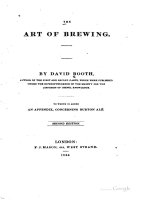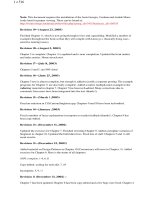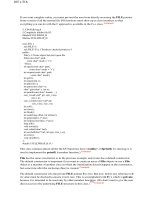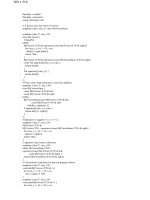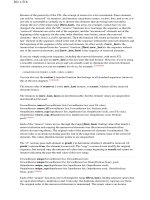0321601661 {84c19800} the rails 3 way (2nd ed ) fernandez 2010 12 20
Bạn đang xem bản rút gọn của tài liệu. Xem và tải ngay bản đầy đủ của tài liệu tại đây (5.13 MB, 760 trang )
www.it-ebooks.info
Praise for the Previous Edition
This encyclopedic book is not only a definitive Rails reference, but an indispensable
guide to Software-as-a-Service coding techniques for serious craftspersons. I keep a
copy in the lab, a copy at home, and a copy on each of my three e-book readers,
and it’s on the short list of essential resources for my undergraduate software engineering
course.
—Armando Fox, adjunct associate professor, University of California, Berkeley
Everyone interested in Rails, at some point, has to follow The Rails Way.
—Fabio Cevasco, senior technical writer, Siemens AG, and blogger at H3RALD.com
I can positively say that it’s the single best Rails book ever published to date. By a long
shot.
—Antonio Cangiano, software engineer and technical evangelist at IBM
This book is a great crash course in Ruby on Rails! It doesn’t just document the features
of Rails, it filters everything through the lens of an experienced Rails developer—so you
come our a pro on the other side.
—Dirk Elmendorf, co-founder of Rackspace, and Rails developer since 2005
The key to The Rails Way is in the title. It literally covers the “way” to do almost
everything with Rails. Writing a truly exhaustive reference to the most popular Web
application framework used by thousands of developers is no mean feat. A thankful
i
www.it-ebooks.info
community of developers that has struggled to rely on scant documentation will embrace
The Rails Way with open arms. A tour de force!
—Peter Cooper, editor, Ruby Inside
In the past year, dozens of Rails books have been rushed to publication. A handful
are good. Most regurgitate rudimentary information easily found on the Web. Only
this book provides both the broad and deep technicalities of Rails. Nascent and expert
developers, I recommend you follow The Rails Way.
—Martin Streicher, chief technology officer, McLatchy Interactive; former editor-inchief of Linux Magazine
Hal Fulton’s The Ruby Way has always been by my side as a reference while programming
Ruby. Many times I had wished there was a book that had the same depth and attention
to detail, only focused on the Rails framework. That book is now here and hasn’t left
my desk for the past month.
—Nate Klaiber, Ruby programmer
As noted in my contribution to the Afterword: “What Is the Rails Way (To You)?,” I
knew soon after becoming involved with Rails that I had found something great. Now,
with Obie’s book, I have been able to step into Ruby on Rails development coming from
.NET and be productive right away. The applications I have created I believe to be a
much better quality due to the techniques I learned using Obie’s knowledge.
—Robert Bazinet, InfoQ.com, .NET and Ruby community editor, and founding member of the Hartford, CT, Ruby Brigade
Extremely well written; it’s a resource that every Rails programmer should have. Yes, it’s
that good.
—Reuven Lerner, Linux Journal columnist
www.it-ebooks.info
THE RAILS™ 3 WAY
www.it-ebooks.info
informit.com /ruby
Addison-Wesley Professional Ruby Series
www.it-ebooks.info
THE RAILS™ 3 WAY
Obie Fernandez
Upper Saddle River, NJ • Boston • Indianapolis • San Francisco
New York • Toronto • Montreal • London • Munich • Paris • Madrid
Capetown • Sydney • Tokyo • Singapore • Mexico City
www.it-ebooks.info
Many of the designations used by manufacturers and sellers to distinguish their products are claimed as trademarks.
Where those designations appear in this book, and the publisher was aware of a trademark claim, the designations
have been printed with initial capital letters or in all capitals.
The author and publisher have taken care in the preparation of this book, but make no expressed or implied
warranty of any kind and assume no responsibility for errors or omissions. No liability is assumed for incidental or
consequential damages in connection with or arising out of the use of the information or programs contained herein.
The publisher offers excellent discounts on this book when ordered in quantity for bulk purchases or special sales,
which may include electronic versions and/or custom covers and content particular to your business, training goals,
marketing focus, and branding interests. For more information, please contact:
Editor-in-Chief
Mark Taub
Executive Acquisitions Editor
Debra Williams Cauley
Managing Editor
John Fuller
Project Editor
Elizabeth Ryan
Copy Editor
Carol Loomis
U.S. Corporate and Government Sales
(800) 382-3419
Indexer
Valerie Haynes Perry
For sales outside the United States please contact:
International Sales
Proofreader
Erica Orloff
Publishing Coordinator
Kim Boedigheimer
Visit us on the Web: informit.com/aw
Library of Congress Cataloging-in-Publication Data
Fernandez, Obie.
The rails 3 way / Obie Fernandez.
p. cm.
Rev. ed. of: The Rails way / Obie Fernandez. 2008.
Includes index.
ISBN 0-321-60166-1 (pbk. : alk. paper)
1. Ruby on rails (Electronic resource) 2. Object-oriented programming (Computer science)
3. Ruby (Computer program language) 4. Web site development. 5. Application
software–Development. I. Fernandez, Obie. Rails way. II. Title.
QA76.64.F47 2010
005.1’17–dc22
2010038744
Copyright © 2011 Pearson Education, Inc.
All rights reserved. Printed in the United States of America. This publication is protected by copyright, and
permission must be obtained from the publisher prior to any prohibited reproduction, storage in a retrieval system,
or transmission in any form or by any means, electronic, mechanical, photocopying, recording, or likewise. For
information regarding permissions, write to:
Pearson Education, Inc.
Rights and Contracts Department
501 Boylston Street, Suite 900
Boston, MA 02116
Fax: (617) 671-3447
Parts of this book contain material excerpted from the Ruby and Rails source code and API documentation,
Copyright © 2004–2011 by David Heinemeier Hansson under the MIT license. Chapter 18 contains material
excerpted from the RSpec source code and API documentation, Copyright © 2005-2011 The RSpec Development
Team.
The MIT License reads: Permission is hereby granted, free of charge, to any person obtaining a copy of this
software and associated documentation files (the “Software”), to deal in the Software without restriction, including
without limitation the rights to use, copy, modify, merge, publish, distribute, sublicense, and/or sell copies of the
Software, and to permit persons to whom the Software is furnished to do so, subject to the following conditions:
The above copyright notice and this permission notice shall be included in all copies or substantial portions of the
Software. THE SOFTWARE IS PROVIDED “AS IS,” WITHOUT WARRANTY OF ANY KIND, EXPRESS
OR IMPLIED, INCLUDING BUT NOT LIMITED TO THE WARRANTIES OF MERCHANTABILITY,
FITNESS FOR A PARTICULAR PURPOSE, AND NONINFRINGEMENT. IN NO EVENT SHALL THE
AUTHORS OR COPYRIGHT HOLDERS BE LIABLE FOR ANY CLAIM, DAMAGES, OR OTHER
LIABILITY, WHETHER IN AN ACTION OF CONTRACT, TORT, OR OTHERWISE, ARISING FROM,
OUT OF OR IN CONNECTION WITH THE SOFTWARE OR THE USE OF OR OTHER DEALINGS IN
THE SOFTWARE.
ISBN-13: 978-0-321-60166-7
ISBN-10:
0-321-60166-1
Text printed in the United States on recycled paper at Edwards Brothers in Ann Arbor, Michigan.
First printing, December 2010
www.it-ebooks.info
Cover Designer
Chuti Prasertsith
Compositor
Glyph International
To Dad, thanks for teaching me ambition.
www.it-ebooks.info
This page intentionally left blank
www.it-ebooks.info
Contents
Foreword by David Heinemeier Hansson
Foreword by Yehuda Katz xxxv
Introduction xxxvii
Acknowledgments xliii
About the Author xlv
Chapter 1
1.1
1.2
1.3
1.4
1.5
xxxiii
Rails Environments and Configuration 1
Bundler 2
1.1.1
Gemfile 3
1.1.2
Installing Gems 5
1.1.3
Gem Locking 7
1.1.4
Packaging Gems 7
Startup and Application Settings 8
1.2.1
application.rb 8
1.2.2
Initializers 11
1.2.3
Additional Configuration 15
Development Mode 15
1.3.1
Automatic Class Reloading 16
1.3.2
Whiny Nils 18
1.3.3
Error Reports 18
1.3.4
Caching 18
1.3.5
Raise Delivery Errors 19
Test Mode 19
Production Mode 20
ix
www.it-ebooks.info
Contents
x
1.6
1.7
1.5.1
Asset Hosts 22
1.5.2
Threaded Mode 22
Logging 23
1.6.1
Rails Log Files 24
1.6.2
Log File Analysis 26
Conclusion 29
Chapter 2
2.1
2.2
2.3
2.4
2.5
2.6
2.7
Routing 31
The Two Purposes of Routing 32
The routes.rb File 33
2.2.1
Regular Routes 34
2.2.2
URL Patterns 35
2.2.3
Segment Keys 36
2.2.4
Spotlight on the :id Field 38
2.2.5
Optional Segment Keys 38
2.2.6
Constraining Request Methods 38
2.2.7
Redirect Routes 39
2.2.8
The Format Segment 40
2.2.9
Routes as Rack Endpoints 41
2.2.10 Accept Header 42
2.2.11 Segment Key Constraints 43
2.2.12 The Root Route 44
Route Globbing 45
Named Routes 46
2.4.1
Creating a Named Route 46
2.4.2
name path vs. name url 47
2.4.3
What to Name Your Routes 48
2.4.4
Argument Sugar 49
2.4.5
A Little More Sugar with Your Sugar?
Scoping Routing Rules 50
2.5.1
Controller 51
2.5.2
Path Prefix 51
2.5.3
Name Prefix 52
2.5.4
Namespaces 52
2.5.5
Bundling Constraints 52
Listing Routes 53
Conclusion 54
www.it-ebooks.info
50
Contents
xi
Chapter 3
3.1
3.2
3.3
3.4
3.5
3.6
3.7
3.8
3.9
3.10
3.11
3.12
REST, Resources, and Rails 55
REST in a Rather Small Nutshell 55
Resources and Representations 56
REST in Rails 57
Routing and CRUD 58
3.4.1
REST Resources and Rails 59
3.4.2
From Named Routes to REST Support 59
3.4.3
Reenter the HTTP Verb 60
The Standard RESTful Controller Actions 61
3.5.1
Singular and Plural RESTful Routes 62
3.5.2
The Special Pairs: new/create and edit/update
3.5.3
The PUT and DELETE Cheat 64
3.5.4
Limiting Routes Generated 64
Singular Resource Routes 64
Nested Resources 65
3.7.1
RESTful Controller Mappings 66
3.7.2
Considerations 67
3.7.3
Deep Nesting? 67
3.7.4
Shallow Routes 68
RESTful Route Customizations 69
3.8.1
Extra Member Routes 70
3.8.2
Extra Collection Routes 72
3.8.3
Custom Action Names 72
3.8.4
Mapping to a Different Controller 72
3.8.5
Routes for New Resources 73
3.8.6
Considerations for Extra Routes 73
Controller-Only Resources 74
Different Representations of Resources 76
3.10.1 The respond to Method 76
3.10.2 Formatted Named Routes 77
The RESTful Rails Action Set 78
3.11.1 Index 78
3.11.2 Show 80
3.11.3 Destroy 80
3.11.4 New and Create 81
3.11.5 Edit and Update 82
Conclusion 83
www.it-ebooks.info
63
Contents
xii
Chapter 4
4.1
4.2
4.3
4.4
4.5
4.6
4.7
4.8
4.9
4.10
Working with Controllers 85
Rack 86
4.1.1
Configuring Your Middleware Stack 87
Action Dispatch: Where It All Begins 88
4.2.1
Request Handling 89
4.2.2
Getting Intimate with the Dispatcher 89
Render unto View 92
4.3.1
When in Doubt, Render 92
4.3.2
Explicit Rendering 93
4.3.3
Rendering Another Action’s Template 93
4.3.4
Rendering a Different Template Altogether 94
4.3.5
Rendering a Partial Template 95
4.3.6
Rendering Inline Template Code 96
4.3.7
Rendering Text 96
4.3.8
Rendering Other Types of Structured Data 96
4.3.9
Rendering Nothing 97
4.3.10 Rendering Options 98
Additional Layout Options 101
Redirecting 101
4.5.1
The redirect to Method 102
Controller/View Communication 104
Filters 105
4.7.1
Filter Inheritance 106
4.7.2
Filter Types 107
4.7.3
Filter Chain Ordering 108
4.7.4
Around Filters 109
4.7.5
Filter Chain Skipping 110
4.7.6
Filter Conditions 110
4.7.7
Filter Chain Halting 111
Verification 111
4.8.1
Example Usage 111
4.8.2
Options 112
Streaming 112
4.9.1
Via render :text => proc 112
send data(data, options ={}) 113
4.9.2
send file(path, options = {}) 114
4.9.3
Conclusion 117
www.it-ebooks.info
Contents
xiii
Chapter 5
5.1
5.2
5.3
5.4
5.5
5.6
Working with Active Record 119
The Basics 120
Macro-Style Methods 121
5.2.1
Relationship Declarations 121
5.2.2
Convention over Configuration 122
5.2.3
Setting Names Manually 122
5.2.4
Legacy Naming Schemes 122
Defining Attributes 123
5.3.1
Default Attribute Values 123
5.3.2
Serialized Attributes 125
CRUD: Creating, Reading, Updating, Deleting 127
5.4.1
Creating New Active Record Instances 127
5.4.2
Reading Active Record Objects 128
5.4.3
Reading and Writing Attributes 128
5.4.4
Accessing and Manipulating Attributes Before They
Are Typecast 131
5.4.5
Reloading 131
5.4.6
Cloning 131
5.4.7
Dynamic Attribute-Based Finders 132
5.4.8
Dynamic Scopes 133
5.4.9
Custom SQL Queries 133
5.4.10 The Query Cache 135
5.4.11 Updating 136
5.4.12 Updating by Condition 137
5.4.13 Updating a Particular Instance 138
5.4.14 Updating Specific Attributes 139
5.4.15 Convenience Updaters 139
5.4.16 Touching Records 139
5.4.17 Controlling Access to Attributes 140
5.4.18 Readonly Attributes 141
5.4.19 Deleting and Destroying 141
Database Locking 142
5.5.1
Optimistic Locking 143
5.5.2
Pessimistic Locking 145
5.5.3
Considerations 145
Where Clauses 146
5.6.1
where(*conditions) 146
www.it-ebooks.info
Contents
xiv
5.7
5.8
5.9
5.10
5.6.2
order(*clauses) 148
limit(number) and offset(number) 149
5.6.3
select(*clauses) 149
5.6.4
5.6.5
from(*tables) 150
group(*args) 150
5.6.6
having(*clauses) 150
5.6.7
5.6.8
includes(*associations) 151
joins 151
5.6.9
5.6.10 readonly 152
5.6.11 exists? 152
5.6.12 arel—table 152
Connections to Multiple Databases in Different Models 153
Using the Database Connection Directly 154
5.8.1
The DatabaseStatements Module 154
5.8.2
Other Connection Methods 156
Other Configuration Options 158
Conclusion 159
Chapter 6
6.1
6.2
6.3
6.4
6.5
6.6
Creating Migrations 161
6.1.1
Sequencing Migrations 162
6.1.2
Irreversible Migrations 162
create—table(name, options, & block) 164
6.1.3
change—table(table name, & block) 165
6.1.4
6.1.5
API Reference 165
6.1.6
Defining Columns 167
6.1.7
Command-line Column Declarations 172
Data Migration 173
6.2.1
Using SQL 173
6.2.2
Migration Models 174
schema.rb 174
Database Seeding 175
Database-Related Rake Tasks 176
Conclusion 179
Chapter 7
7.1
7.2
Active Record Migrations 161
Active Record Associations 181
The Association Hierarchy 181
One-to-Many Relationships 183
www.it-ebooks.info
Contents
7.3
7.4
7.5
7.6
7.7
7.8
7.9
7.10
xv
7.2.1
Adding Associated Objects to a Collection 185
7.2.2
Association Collection Methods 186
The belongs—to Association 191
7.3.1
Reloading the Association 192
7.3.2
Building and Creating Related Objects via the Association
7.3.3
belongs—to Options 193
The has—many Association 200
has—many Options 200
7.4.1
Many-to-Many Relationships 209
7.5.1
has—and—belongs—to—many 209
has—many :through 215
7.5.2
has—many :through Options 220
7.5.3
One-to-One Relationships 223
has—one 223
7.6.1
Working with Unsaved Objects and Associations 226
7.7.1
One-to-One Associations 226
7.7.2
Collections 226
7.7.3
Deletion 227
Association Extensions 227
The AssociationProxy Class 229
Conclusion 230
Chapter 8
8.1
8.2
Validations 231
Finding Errors 231
The Simple Declarative Validations 232
validates—acceptance—of 232
8.2.1
validates—associated 233
8.2.2
8.2.3
validates—confirmation—of 233
validates—each 234
8.2.4
validates—format—of 235
8.2.5
8.2.6
validates—inclusion—of
and validates—exclusion—of 236
validates—length—of 236
8.2.7
8.2.8
validates—numericality—of 237
validates—presence—of 238
8.2.9
8.2.10 validates—uniqueness—of 239
8.2.11 validates—with 241
8.2.12 RecordInvalid 242
www.it-ebooks.info
192
Contents
xvi
8.3
8.4
8.5
8.6
8.7
8.8
8.9
8.10
Common Validation Options 242
:allow—blank and :allow—nil 242
8.3.1
:if and :unless 242
8.3.2
8.3.3
:message 242
:on 243
8.3.4
Conditional Validation 243
8.4.1
Usage and Considerations 244
8.4.2
Validation Contexts 245
Short-form Validation 245
Custom Validation Techniques 246
8.6.1
Add Custom Validation Macros to Your Application
8.6.2
Create a Custom Validator Class 248
8.6.3
Add a validate Method to Your Model 248
Skipping Validations 249
Working with the Errors Hash 249
8.8.1
Checking for Errors 250
Testing Validations with Shoulda 250
Conclusion 250
Chapter 9
9.1
9.2
247
Advanced Active Record 251
Scopes 251
9.1.1
Scope Parameters 252
9.1.2
Chaining Scopes 252
9.1.3
Scopes and has many 252
9.1.4
Scopes and Joins 253
9.1.5
Scope Combinations 253
9.1.6
Default Scopes 254
9.1.7
Using Scopes for CRUD 255
Callbacks 256
9.2.1
Callback Registration 256
9.2.2
One-Liners 257
9.2.3
Protected or Private 257
9.2.4
Matched before/after Callbacks 258
9.2.5
Halting Execution 259
9.2.6
Callback Usages 259
9.2.7
Special Callbacks: after—initialize and after—find
9.2.8
Callback Classes 263
www.it-ebooks.info
262
Contents
9.3
9.4
9.5
9.6
9.7
9.8
9.9
9.10
9.11
9.12
xvii
Calculation Methods 265
average(column—name, *options) 267
9.3.1
count(column—name, *options) 267
9.3.2
9.3.3
maximum(column—name, *options) 267
minimum(column—name, *options) 267
9.3.4
9.3.5
sum(column—name, *options) 267
Observers 268
9.4.1
Naming Conventions 268
9.4.2
Registration of Observers 269
9.4.3
Timing 269
Single-Table Inheritance (STI) 269
9.5.1
Mapping Inheritance to the Database 271
9.5.2
STI Considerations 273
9.5.3
STI and Associations 274
Abstract Base Model Classes 276
Polymorphic has many Relationships 277
9.7.1
In the Case of Models with Comments 278
Foreign-key Constraints 281
Using Value Objects 281
9.9.1
Immutability 283
9.9.2
Custom Constructors and Converters 283
9.9.3
Finding Records by a Value Object 284
Modules for Reusing Common Behavior 285
9.10.1 A Review of Class Scope and Contexts 287
9.10.2 The included Callback 288
Modifying Active Record Classes at Runtime 289
9.11.1
Considerations 290
9.11.2
Ruby and Domain-Specific Languages 291
Conclusion 292
Chapter 10
10.1
Action View 293
Layouts and Templates 294
10.1.1 Template Filename Conventions
10.1.2 Layouts 294
10.1.3 Yielding Content 295
10.1.4 Conditional Output 296
10.1.5 Decent Exposure 297
294
www.it-ebooks.info
Contents
xviii
10.1.6 Standard Instance Variables 298
10.1.7 Displaying flash Messages 300
10.1.8 flash.now 301
10.2 Partials 302
10.2.1 Simple Use Cases 302
10.2.2 Reuse of Partials 303
10.2.3 Shared Partials 304
10.2.4 Passing Variables to Partials 305
10.2.5 Rendering Collections 306
10.2.6 Logging 308
10.3 Conclusion 308
Chapter 11
11.1
11.2
11.3
11.4
11.5
11.6
11.7
11.8
All About Helpers 309
309
11.1.1 Reporting Validation Errors 310
11.1.2 Automatic Form Creation 313
11.1.3 Customizing the Way Validation Errors Are Highlighted
AssetTagHelper 316
11.2.1 Head Helpers 316
11.2.2 Asset Helpers 319
11.2.3 Using Asset Hosts 321
11.2.4 Using Asset Timestamps 323
11.2.5 For Plugins Only 324
AtomFeedHelper 324
CacheHelper 326
CaptureHelper 326
DateHelper 328
11.6.1 The Date and Time Selection Helpers 328
11.6.2 The Individual Date and Time Select Helpers 329
11.6.3 Common Options for Date Selection Helpers 332
11.6.4 distance—in—time Methods with Complex
Descriptive Names 332
DebugHelper 333
FormHelper 333
11.8.1 Creating Forms for Models 334
11.8.2 How Form Helpers Get Their Values 342
11.8.3 Integrating Additional Objects in One Form 343
ActiveModelHelper
www.it-ebooks.info
315
Contents
xix
11.8.4
11.8.5
11.9
11.10
11.11
11.12
11.13
11.14
11.15
11.16
11.17
11.18
11.19
11.20
Customized Form Builders
Form Inputs 348
FormOptionsHelper 350
11.9.1 Select Helpers 350
11.9.2 Option Helpers 351
FormTagHelper 355
JavaScriptHelper 358
NumberHelper 359
PrototypeHelper 361
RawOutputHelper 361
RecordIdentificationHelper 362
RecordTagHelper 363
SanitizeHelper 364
TagHelper 366
TextHelper 367
TranslationHelper and the I18n API 372
11.20.1
11.20.2
11.20.3
11.20.4
11.20.5
11.20.6
11.20.7
11.20.8
11.20.9
11.20.10
11.21
11.22
11.23
11.24
347
Localized Views
373
TranslationHelper Methods
374
I18n Setup 374
Setting and Passing the Locale 375
Setting Locale from Client Supplied Information 379
Internationalizing Your Application 380
Organization of Locale Files 382
Looking up Translations 383
How to Store Your Custom Translations 386
Overview of Other Built-In Methods that Provide
I18n Support 388
11.20.11 Exception Handling 391
UrlHelper 391
Writing Your Own View Helpers 398
11.22.1 Small Optimizations: The Title Helper 398
11.22.2 Encapsulating View Logic: The photo for Helper 399
11.22.3 Smart View: The breadcrumbs Helper 400
Wrapping and Generalizing Partials 401
11.23.1 A tiles Helper 401
11.23.2 Generalizing Partials 404
Conclusion 407
www.it-ebooks.info
Contents
xx
Chapter 12
12.1
12.2
12.3
12.4
12.5
12.6
12.0.1 Changes in Rails 3 410
12.0.2 Firebug 410
Unobtrusive JavaScript 411
12.1.1 UJS Usage 411
Writing JavaScript in Ruby with RJS 412
12.2.1 RJS Templates 414
12.2.2 <<(javascript) 415
12.2.3 [](id) 415
12.2.4 alert(message) 416
12.2.5 call(function, *arguments, & block) 416
12.2.6 delay(seconds = 1) ... 416
12.2.7 draggable(id, options = {}) 416
12.2.8 drop receiving(id, options = {}) 417
12.2.9 hide(*ids) 417
12.2.10 insert—html(position, id, *options—for—render)
12.2.11 literal(code) 417
12.2.12 redirect to(location) 418
12.2.13 remove(*ids) 418
12.2.14 replace(id, *options for render) 418
12.2.15 replace html(id, *options for render) 418
12.2.16 select(pattern) 418
12.2.17 show(*ids) 418
12.2.18 sortable(id, options = {}) 418
12.2.19 toggle(*ids) 419
12.2.20 visual effect(name, id = nil, options = {}) 419
Ajax and JSON 419
12.3.1 Ajax link to 419
Ajax and HTML 421
Ajax and JavaScript 423
Conclusion 424
Chapter 13
13.1
Ajax on Rails 409
Session Management 425
What to Store in the Session 426
13.1.1 The Current User 426
13.1.2 Session Use Guidelines 426
www.it-ebooks.info
417
Contents
xxi
13.2
13.3
Session Options 427
Storage Mechanisms 427
13.3.1 Active Record Session Store 427
13.3.2 Memcache Session Storage 428
13.3.3 The Controversial CookieStore 429
13.3.4 Cleaning Up Old Sessions 430
13.4 Cookies 431
13.4.1 Reading and Writing Cookies 431
13.5 Conclusion 432
Chapter 14
Authentication 433
14.1
Authlogic 434
14.1.1 Getting Started 434
14.1.2 Creating the Models 434
14.1.3 Setting Up the Controllers 435
14.1.4 Controller, Limiting Access to Actions
14.1.5 Configuration 437
14.1.6 Summary 439
14.2 Devise 439
14.2.1 Getting Started 439
14.2.2 Modules 439
14.2.3 Models 440
14.2.4 Controllers 441
14.2.5 Devise, Views 442
14.2.6 Configuration 442
14.2.7 Extensions 443
14.2.8 Summary 443
14.3 Conclusion 443
Chapter 15
15.1
XML and Active Resource 445
The to—xml Method 445
15.1.1 Customizing to—xml Output 446
15.1.2 Associations and to—xml 448
15.1.3 Advanced to—xml Usage 451
15.1.4 Dynamic Runtime Attributes 452
15.1.5 Overriding to—xml 453
www.it-ebooks.info
436
Contents
xxii
15.2
15.3
The XML Builder 454
Parsing XML 456
15.3.1 Turning XML into Hashes 456
15.3.2 Typecasting 457
15.4 Active Resource 457
15.4.1 List 458
15.4.2 Show 459
15.4.3 Create 460
15.4.4 Update 462
15.4.5 Delete 462
15.4.6 Headers 462
15.4.7 Customizing URLs 463
15.4.8 Hash Forms 464
15.5 Active Resource Authentication 465
15.5.1 HTTP Basic Authentication 465
15.5.2 HTTP Digest Authentication 466
15.5.3 Certificate Authentication 466
15.5.4 Proxy Server Authentication 466
15.5.5 Authentication in the Web Service Controller
15.6 Conclusion 469
Chapter 16
16.1
16.2
16.3
16.4
16.5
16.6
Action Mailer 471
Setup 471
Mailer Models 472
16.2.1 Preparing Outbound Email Messages 472
16.2.2 HTML Email Messages 474
16.2.3 Multipart Messages 475
16.2.4 Attachments 475
16.2.5 Generating URLs 476
16.2.6 Mailer Layouts 476
16.2.7 Sending an Email 477
Receiving Emails 477
16.3.1 Handling Incoming Attachments 478
Server Configuration 479
Testing Email Content 479
Conclusion 481
www.it-ebooks.info
467
Contents
xxiii
Chapter 17
17.1
17.2
17.3
17.4
17.5
View Caching 483
17.1.1 Caching in Development Mode? 484
17.1.2 Page Caching 484
17.1.3 Action Caching 484
17.1.4 Fragment Caching 486
17.1.5 Expiration of Cached Content 488
17.1.6 Automatic Cache Expiry with Sweepers 490
17.1.7 Cache Logging 492
17.1.8 Action Cache Plugin 492
17.1.9 Cache Storage 493
General Caching 495
17.2.1 Eliminating Extra Database Lookups 495
17.2.2 Initializing New Caches 496
17.2.3 fetch Options 496
Control Web Caching 497
17.3.1 expires—in(seconds, options = {}) 498
17.3.2 expires—now 498
ETags 498
17.4.1 fresh—when(options) 499
17.4.2 stale?(options) 499
Conclusion 500
Chapter 18
18.1
18.2
Caching and Performance 483
RSpec 501
Introduction 501
Basic Syntax and API 504
18.2.1 describe and context 504
18.2.2 let(:name) (expression) 504
18.2.3 let!(:name) (expression) 506
18.2.4 before and after 506
18.2.5 it 507
18.2.6 specify 507
18.2.7 expect 508
18.2.8 pending 509
18.2.9 should and should—not 510
18.2.10 Implicit Subject 511
www.it-ebooks.info
Contents
xxiv
18.3
18.4
18.5
18.6
18.7
18.8
18.9
18.10
18.2.11 Explicit Subject 511
18.2.12 its 512
Predicate Matchers 513
Custom Expectation Matchers 514
18.4.1 Custom Matcher DSL 516
18.4.2 Fluent Chaining 516
Shared Behaviors 517
RSpec’s Mocks and Stubs 517
Running Specs 520
RSpec Rails Gem 521
18.8.1 Installation 521
18.8.2 Model Specs 524
18.8.3 Mocked and Stubbed Models
18.8.4 Controller Specs 526
18.8.5 View Specs 529
18.8.6 Helper Specs 531
RSpec Tools 531
18.9.1 RSpactor 531
18.9.2 watchr 532
18.9.3 Spork 532
18.9.4 Specjour 532
18.9.5 RCov 532
18.9.6 Heckle 532
Conclusion 533
Chapter 19
526
Extending Rails with Plugins 535
19.1
The Plugin System 536
19.1.1 Plugins as RubyGems 536
19.1.2 The Plugin Script 536
19.2 Writing Your Own Plugins 537
19.2.1 The init.rb Hook 538
19.2.2 The lib Directory 539
19.2.3 Extending Rails Classes 540
19.2.4 The README and MIT-LICENSE File 541
19.2.5 The install.rb and uninstall.rb Files
19.2.6 Custom Rake Tasks 543
www.it-ebooks.info
542


